SB visits… Citadelle Gin
French spirits producer Maison Ferrand has opened up its distillery for Citadelle Gin in the southwest of France to the public for the first time – and SB were part of the lucky few to visit.
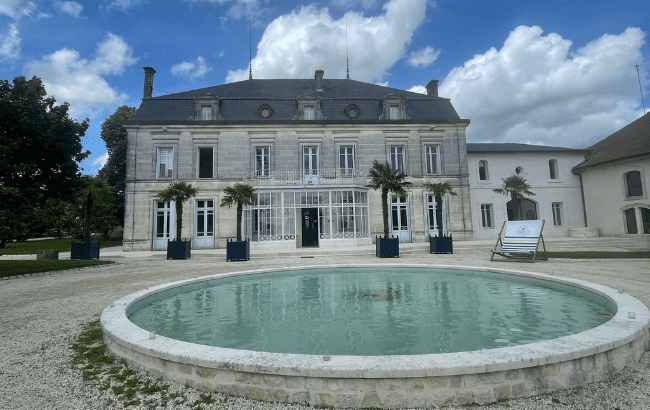
While it’s not our first rodeo in Cognac, this time round we headed to the region for two days on business not entirely centred around its namesake spirit, as it’s also the home of Citadelle Gin, a French gin brand founded in 1996 by Alexandre Gabriel.
Citadelle now outpaces Ferrand Cognac for global sales, though its still behind Planteray Rum as Maison Ferrand’s largest-selling brand.
Gabriel, along with his wife Debbie Gabriel and their in-house team, opened the new distillery for Citadelle in 2021, to mark the brand’s 25th anniversary. It’s now officially open to the public, so gin enthusiasts can see in person, for the first time, how the brand crafts its range of products – through a behind-the-scenes tour of the property, which takes you around juniper fields to the copper stills from where the gin is distilled over an open fire to the new bar space from where you can enjoy a refreshing gin and tonic over apéro hour.
The Gabriel’s reside here too, when Alexandre isn’t in Paris or Barbados, so in a sense this was somewhat a glimpse into their home and lives as well.
Day one: Citadelle Gin
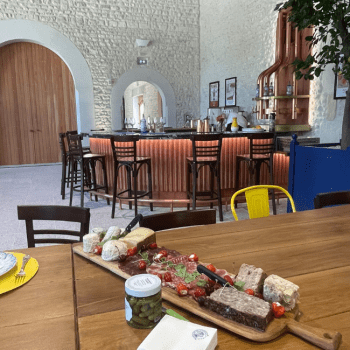
To reach the distillery, it’s roughly a 20-minute drive away from downtown Cognac, or an hour and a half from Bordeaux airport, to the countryside-esque village of Ars. The distillery itself is within an 18th-century stone building in Maison Ferrand’s Château de Bonbonnet estate – which is also where Alexandre matures barrels for Planteray Rum and has offices for Ferrand Cognac. It’s essentially the hub for all Ferrand operations.
With a group of fellow drinks journalists, SB arrived at the gates of the impressive Château de Bonbonnet, (see main picture above for reference) just in time for a ‘light lunch’, welcomed by the Gabriel’s themselves.
This involved charcuterie, pates and cheeses, or fromage as they say in France, and oysters (doused in gin) among other delicacies such as a cherry chafulis cake made by Debbie. Paired with a gin and tonic, it did the trick in snapping us out of our post-flight funk. And it was also a preview of how much emphasis the brand places on local produce.
Well-fed, it was then time to sample the new experience and see what the brand is all about, before we got too comfortable in our chairs eating cheese. Our first stop was outside for a look around the juniper fields, which is where the brand grows its berries – hanging from around roughly 2,500 juniper plants. The fields are less than a stone throw away from the estate, right outside the property.
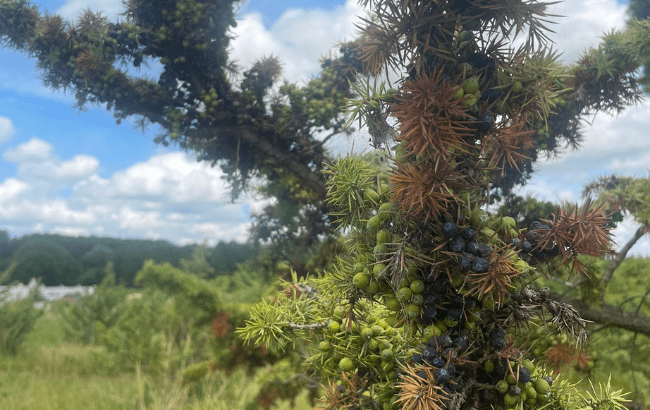
The harvest is said to be around November time and we were even allowed to try a few berries for ourselves. ‘Tastes like juniper’ was our verdict. Gabriel explained to us that the brand’s bottles are coloured blue to match the juniper berries they grow. Though it might seem obvious, you don’t want the green ones, he said to us.
After getting a brief on the juniper’s journey from planting to picking (through the use of a tarpaulin net) for distillation, we next made our way over to the greenhouse, named ‘L’orangerie’, which is where the lemons and lime used to flavour the gin are grown. The team cultivates their citrus from here using repurposed waste energy from the distillery. The area is still under construction and for the future, we were told that a bar will be added next summer, as well as a workshop space for the full gin immersive experience. No word on the gin-filled swimming pool though…
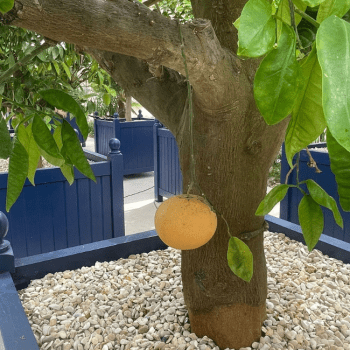
Next it was into the distillery itself, the heart of the operation, and into a building with a cathedral-like feel with stone arches and high ceilings, laid out in such a way as both an ode to the building’s original style and for practicality as it provides peak conditions for gin distillation.
The gins are made with 19 botanicals (the recipe is a secret, of course) and are distilled in refurbished Charentais copper Cognac pots. This is done by what the team calls ‘progressive infusion’ – a technique mastered by Gabriel where you don’t put everything together all at once, instead you put it in so it has the optimum time, or exact flavour profile that you want to be imparted into the liquid. Citrus flavours are extracted at a different time to angelica root and the rest, for example.
The space is also occupied by nine stills built 50 or so years ago by local craftsmen. As admirers of stills, they were a stirring sight and a nice piece of history.
Underneath Château de Bonbonnet, we were then led down to the old cellar area (mind your head!) that Gabriel and the team are working on further updating. The château has lived a few different lives in the past, from a horse stable to another Cognac distillery, and many artefacts from the cellars have been kept, including centuries-old baskets and pots for ageing.
Back on ground level, when then took a quick breather from gin to try Planteray Rum rum from the barrels matured on site. Over the years, Gabriel has partnered with numerous rum producers from all around the world, including the likes of Panama, Barbados and Fiji. He disclosed that one from Paraguay is on the way for next year.
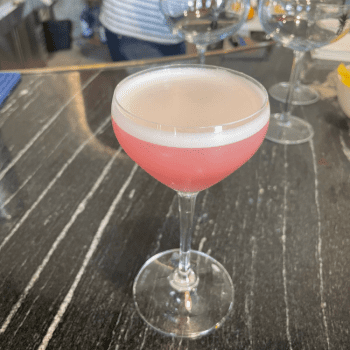
After this, it was time to wrap up the tour at the spice bar and lounge from where they offer a range of cocktails (we did indeed, take them up on the offer), plus some gins from the tap. If any of the gins tickle your fancy, then they can be purchased at the adjacent shop – the visitor centre part – which stock’s the brand’s full lineup, as well Ferrand Cognac and Planteray Rum.
Citadelle is known to be avant-garde with its flavours, which include hot sauce and cornichon expressions, and a distillery-exclusive called The French. Tea-inspired, this is made with green tea from Maison Émile Auté, jasmine flower buds from Bretagne and bergamot oranges from the L’Agrumiste citrus estate in Morocco.
Also of note in the bar: an enormous egg-shaped oak barrel that become a bit of a talking point, stationed in the centre of the room. While its presence was captivating, it does serve a purpose other than looking neat – this is where the brand’s Citadelle Reserve is aged, and the reason for the egg shape is that it ‘keeps the liquid in perpetual motion’. While there has been chatter that this expression may be discontinued, it will be available for purchase from the visitor centre shop instead.
As night fell we were then treated to a barbecue, before retreating to an open fire pit where we would prepare ourselves for the next day and second part of the trip, with more cocktails.
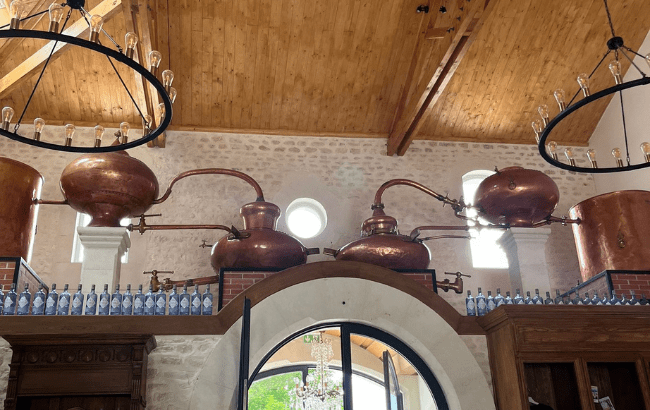
Day two: Ferrand Cognac
Well-rested and up early, day two was a chance for us to see what else Maison Ferrand has in store, beyond Citadelle Gin. When in Rome and all that. We began the morning at Mademoiselle Château, which we were informed is where Henriette Ranson-Ferrand lived before she passed away at the age of 94. Ranson-Ferrand was the last living member of the Ferrand family and dedicated her years to preserving the family memory.
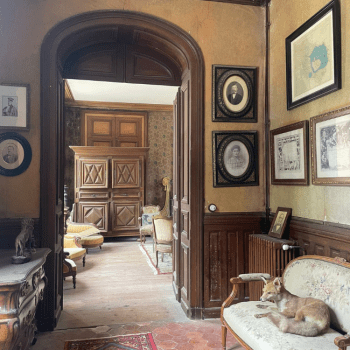
As you can see from the picture on the right, she was also quite the hoarder and the team have gone to great lengths to preserve everything she kept. Ongoing, the project started in 2016. The hope in time is that it will become a museum. There’s old magazines, paintings, newspapers, eerie clothes from the family, even eerier taxidermy and very old Cognac, of course. We were fortunate enough to manage to sneak in a few drops of stuff from 1962 in the cellar below.
Following this, we were then whisked away for one final pitstop to the Angeac Distillery, the primary site for Ferrand Cognac’s production. Our guide and the brand’s resident historian (that is his title), Jaques Blanc, ran us through Ferrand Cognac and how its made, and then led us into the dark and damp cellars – much to the distress of a few arachnophobes among us. Blanc also offered us the chance to try Cognac that had been distilled in 1952, the oldest liquid yet.
After this, our time with Maison Ferrand drew to a close. A lunch in Cognac itself was followed by a walk through the town and then onto the airport in Bordeaux to catch a flight back to London. As much as we would have loved to have put the rest of the week on hold and drink gin and tonics under the sun back at the château, reality called…
Related news
Cocktail stories: Speed Bump, Byrdi
